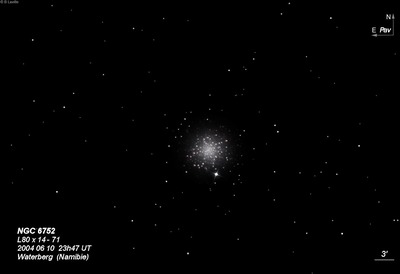
James Dunlop discovered NGC 6752 = D 295 = h3778 on 28 Jul 1826 at Parramatta Observatory (near Sydney) with his homemade 9-inch f/12 reflector. His full description reads: "a pretty large and very bright nebula, 5' or 6' diameter, irregular round figure, easily resolved into a cluster of small stars, exceedingly compressed at the centre. The bright part at the center is occasioned by a group of stars of some considerable magnitude when compared with those of the nebula. I am inclined to think that these may be two clusters in the same line; the bright part is a little south of the centre of the large nebula." He recorded the cluster on 5 times.
JH also made multiple observations. On sweep 480 (7 Aug 1834), he recorded "globular cluster; B; rich; psmbM; 7'. The stars are of 2 magnitudes, the larger 11m, run out in lines like crooked radii. The smaller, 16m, are massed together in and round the middle."
200/250mm - 8" (7/13/91 - Southern Baja): very bright, fairly large, 10' total diameter with a 2' brighter core that increased to very bright nucleus. The large halo was very mottled and partially resolved although viewed at only 6 degrees elevation as the brightest stars are mag 11. 15-20 stars mag 11-12 were visible around the edges of the core and within the halo in curved strings. Mag 7.7 SAO 254482 (h5085 = 7.7/9.2 at 2.8") is embedded in the SW portion of the halo 4.3' from the center. Ranks second in terms of brightest individual stars and appears very rich.
300/350mm - 12" (6/29/02 - Bargo, Australia): this naked-eye cluster ranks second in terms of brightest members (mag 11.5). The 4' core has several dozen mag 12-13 stars, many arranged in streaming curves and chains layered over a dense central glow. The halo is large but irregular with knots of mag 11-12 stars over a diffuse background. The brighter members, particularly in the outer halo give the visual appearance of a globular embedded in a larger, open cluster!
400/500mm - 18" (7/10/02 - Magellan Observatory, Australia): NGC 6752 is one of the top globular clusters (4th brightest in integrated magnitude and 2nd in terms of brightest members) and was spectacular from Magellan Observatory. At 128x, this naked-eye cluster seemed fully resolved with an uncountable number of stars densely packed over a large region. Streamers in the halo greatly increased the diameter to roughly 20'. The central region was well-compressed to a very bright core! There was a strong 3-dimensional effect as the core was covered with scores of fairly bright stars seemingly superimposed over a rich mat of fainter stars and all set over a background glow. The nucleus was small and very bright. Many 11-12th magnitude stars in the halo formed complete loops and long chains. A mag 7.7 double star is superimposed on the SW edge of the halo (h5085 = 7.7/9.2 at 2.8"). This was one of my favorite objects from Australia!
Notes by Steve Gottlieb